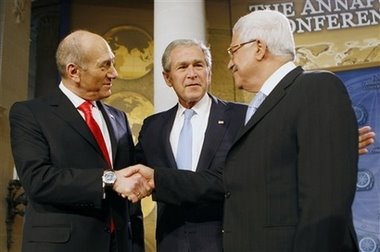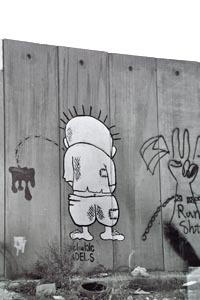
Olmert, Bush, Abbas: trying to save apartheid
Last November, Israeli Prime Minister Ehud Olmert and Palestinian Authority leader Mahmoud Abbas met with US President George Bush in Annapolis, Maryland for the first stage of a new round of “peace talks” – an official society song and dance that the world has not seen in almost six years since the "Road Map to Peace" talks in Taba. Most people outside of the United States (including most Israelis), understand that the so-called “peace process” is a public relations scam, that contrary to the supposed purpose of these talks – the creation of a sovereign Palestinian state and the negotiation of a lasting Israeli-Palestinian peace – the peace talks are actually designed to give international legitimacy to Israeli apartheid regime, and to prolong the day of reckoning when a Palestinian civil rights movement finally dismantles this structure from below.
But why are these new talks just happening now? Why, after six years of dormancy, has the Colonial Fascism Cabaret just come back to town? Is it because of the Hollywood writer’s strike, and there was just no one to write the lines? While this would be a solid guess for those not in the know, the six years of public silence are certainly not for lack of words. Rather, this recent round of peace talks is occurring because of a profound crisis in Israeli apartheid policies and thought, triggered by the very recent and very powerful popular struggles of the Palestinian people. To understand the current phase of official society “dialogue” in Israel/Palestine, we need to look at the recent history of democratic movements among the Palestinians themselves.
In the last two decades, there have been two major anti-colonial uprisings in historic Palestine: the First Intifada, from 1987-1993, and the Second Intifada, from 2000-2004. These movements created an immense political crisis for the Israeli state and official society (not to mention the Palestinian establishment), precisely because they challenged the very foundations of unequal social relations institutionalized in the laws and de facto practices of Israel - relations characterized by ethnic separation and subjugation in a hierarchy of citizenship.
Because as in apartheid South Africa, access to citizenship and civil rights in Israel is defined by race and ethnicity through religion, Jew versus Arab, a system in which Jews have full political rights and Palestinians have modified ones or none at all, depending on where they live.
The two-state solution is no longer a possibility for Palestinians because there cannot be an acceptance of living in bantustans which the Israeli government has created. The paradigmatic shift to an anti-apartheid analysis, signals a possible return to the original program in the PLO charter for a democratic Israel-Palestine for equal rights, for the national Palestinian movement. This is what the Zionist regime fears. The demand for equal rights and citizenship as a goal for the national movement would end, once and for all, the public relations stunts of the "peace process".
Every Israeli and American state official knows this, hence the tirelessly revisited “peace process” and its crucial “two-state solution.” Israeli Prime Minister Ehud Olmert said it best himself during the recent Annapolis talks: ““If the two-state solution collapses, and we face a South African-style struggle for equal voting rights, then the State of Israel is finished.” The Orwellian mirage of a two-state promise is the only way to maintain Israel as a Jewish state, to maintain the rigid ethnic segregation and separate but unequal practices that define the entire social fabric of Israeli society as a whole.
In the Israeli political establishment, there have been two approaches to dealing with these Palestinian democratic challenges to the current state of affairs. One promotes continual military subjugation and even genocide against the Palestinian population – the civilian shoot-to-kill policy during the two Intifadas, or the recent total-war military blockade and economic strangulation of the entire Gazan population, being just two examples of this. The other position advocates the “the two state solution:” a political arrangement where Palestinians are placed on a handful of disconnected and Israeli military regulated ethnic reservations and these reservations are collectively referred to as a “state” against all rational instinct.

Handala's message to apartheid
This second vision is specifically modeled after the South African apartheid regime’s “peace offerings” constructed through the 1960s and 1970s – a series of limited autonomy Bantustans, militarily surrounded and bisected by the apartheid state forces, having no political autonomy and subject to new invasion and occupation at any time. These were the terms of both the Oslo and Camp David Accords. But what unites the first and second vision is that they both share a philosophy of racial manifest destiny and separation, falsely equating the history and identity of Jewish people with the existence of an apartheid state. This philosophy is called Zionism. Zionist justification for Israeli apartheid is intimately tied to notions of superior and inferior races and cultures, often associated with the idea and practice of white supremacy.
Therefore, the context of the Annapolis has to be seen through this goal of empowering Palestinian representatives, whose base of support is the U.S. and Israeli governments, to affirm an international recognition of de facto apartheid. But this cannot be done effectively if grass roots popular democratic resistance is not crushed and at the same time the leading resistance organization, Hamas, is not destroyed. Bush promoted the idea of elections through Abbas, but Abbas lost badly to Hamas. Since the election of Hamas to the bantustan government in 2006, the Israeli government, and the U.S. and European regimes have been working to remove it.
Through their proxies in the Fatah party elite, led by Mahmoud Abbas, Salam Fayyad and Mohammed Dahlan, they were able to carry out a coup. The bantustan government was restored in the West Bank ghettoes to the Fatah elite--who got rich off of the Oslo years in the 1990s, while apartheid was further entrenched-- however they were run out of Gaza, where Hamas has historically deeper roots.
Mohammed Dahlan, close to the Israeli government and the U.S., was directed by Mahmoud Abbas and Salam Fayyad, and flushed with more American and Israeli weapons, to attack and destroy Hamas and any resistance in Gaza and in the West Bank. Although this plan failed in Gaza, it is being carried out in the West Bank bantustans. Now the Palestinian Authority police forces are being overseen by US general Keith Dayton. The goal is to ensure that the work of apartheid goes on undisturbed while Palestinian faces imprison and murder any resistance to it.
If the original goal of the "peace process" in the 1990s was to reestablish the political legitimacy of Israeli apartheid that was quickly fading with the democratic challenges of the first intifada, this time it is more difficult to restore that legitimacy. In the 1990s, the leadership of the Palestinian Liberation Organization was allowed to enter the West Bank and be the Palestinian face of this process. It worked for awhile because despite great disillusionment, Yasser Arafat still had a lot of symbolic legitimacy as the most recognized leader of the historic national movement and leader of Fatah. There is no such illusory legitimacy today. The Palestinian Authority, and the hand-picked people like Fayyad, Abbas and Dahlan, depend completely on American and Israeli government interests.
While Abbas and the PA leadership smile during photo-ops like Annapolis, saying nothing about the structures of apartheid, Israel continues its collective punishment of the Gazan population and is quietly consolidating its apartheid structure in the West Bank as well, strengthening and expanding its infrastructure of Jewish-only towns, Jewish-only roads, IDF checkpoints and the latest "security" wall.
The democratic aspirations of the Palestinian people to be free from apartheid have sent a wave of fear through Israeli (and not to mention American) official society. The election of Hamas to municipal power in Gaza (and the subsequent total war response of the Israeli Defense Forces against the Gazan civilian population) is only one manifestation of this. The recent Annapolis peace talks come on the heels of a growing awareness amongst Israeli rulers that apartheid is losing its legitimacy, and that something must be done on the international scene to preserve the racial character and hierarchy of Israeli society as a whole.
It is important for democratic minded people in the US, and all people of good faith, to support the Palestinian struggle against apartheid and exert real pressure on the Israeli government through divestment and economic boycott here. The American student divestment movement played a critical role in the 1980s in bringing the South African apartheid regime to its knees. It is up to this generation to see that the same solidarity is offered to the Palestinian people as they continue the struggle against colonialism and apartheid in their homeland.



